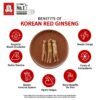- Empty cart.
- Continue Shopping
What is Korean Red Ginseng?

What is Korean Red Ginseng?
Ginseng was first found in Northern China around 5000 years ago, when it was first used as a food. Since then, it has become popular as a medicinal supplement. In fact, ginseng has been used in Eastern medicine since around 200 BC. The famous Swedish botanist Carolus Linnaeus called ginseng “panax,” a word derived from Greek meaning “all-healing.” Ginseng comes from the root of the ginseng plant.
Korean Ginseng, sometimes called panax ginseng or Chinese ginseng, is one of at least thirteen species of ginseng. Like other species of ginseng, Korean ginseng is a herbal supplement made from the fleshy root of the ginseng plant. The ginseng plant, which grows in the mountains of Eastern Asia, is the only source of Korean ginseng. There are two types of Korean ginseng – red and white. Korean Red Ginseng is renowned for its excellent health benefits.
Read on to learn more about Korean Red Ginseng’s many benefits and uses and to find out how you can improve your health with Korean Red Ginseng.
White versus Red Ginseng: What’s the difference?
There are three forms of Korean Ginseng – fresh, red, and white. These different forms are all from the same ginseng plant root. Like other plants, fresh ginseng contains moisture and will only last a few days prior to getting rotten.
White ginseng is dehydrated after the harvest and sold as a dry root or in a powdered form. On the other hand, red ginseng undergoes additional processing – it is dried and steamed. Red ginseng is called such because after treatment by hot air, the roots turn reddish and obtain a glassy, firm appearance. Only ginseng that has been ripened for at least six years can be used for Korean Red Ginseng.
Any white ginseng that goes through a steaming and drying process will become red ginseng. However, what sets Korean Red Ginseng apart is that it is made of roots that are harvested after six years. Ginseng that is harvested after six years has maximal nutrients and components, and the steaming and drying of red ginseng enhances the potency of these components to support good health.
Korean Red Ginseng’s Health Benefits
Korean Red Ginseng has a number of healing properties for the body. Korean Red Ginseng boosts immune system function to help fight off colds and other illness. It also helps promote healthy function of the circulatory system. Korean Red Ginseng also boosts antioxidant activity which helps reduce free radicals’ damaging effect to the body’s tissues, which can lead to cancer and inflammatory conditions. Korean Red Ginseng can help boost memory, as well, and can help women experiencing menopause maintain their health.
The benefits of Korean Red Ginseng are vast and scientifically proven.
What Compounds in Korean Red Ginseng Promote Health?
Two compounds work together to provide health benefits in Korean Red Ginseng. These two substances are ginsenosides and gintonin.
Ginsenosides were identified in 1963 as the primary pharmacological compounds present in ginseng (Leung and Wong, 2010). Ginsenosides have a variety of effects, working as anticancer, anti-inflammatory, antioxidant compounds which promote cell and tissue health. Researchers have identified a potential role for ginsenosides in the prevention and treatment of neurological disorders such as Alzheimer’s disease, Parkinson’s disease, stroke, epilepsy, and depression (Zheng, et al., 2018).
Gintonin is a second compound that has been identified as lending Korean Red Ginseng its many health properties. Like ginsenosides, gintonin promotes cell growth and health, reduces inflammation, and serves as a potent antioxidant compound. Scientists believe that gintonin may contribute to the cognitive improvements associated with taking ginseng, as evidenced by human clinical trials (Im and Nah, 2013).
Ginsenosides and gintonin work together synergistically which gives Korean Red Ginseng its many health benefits.








